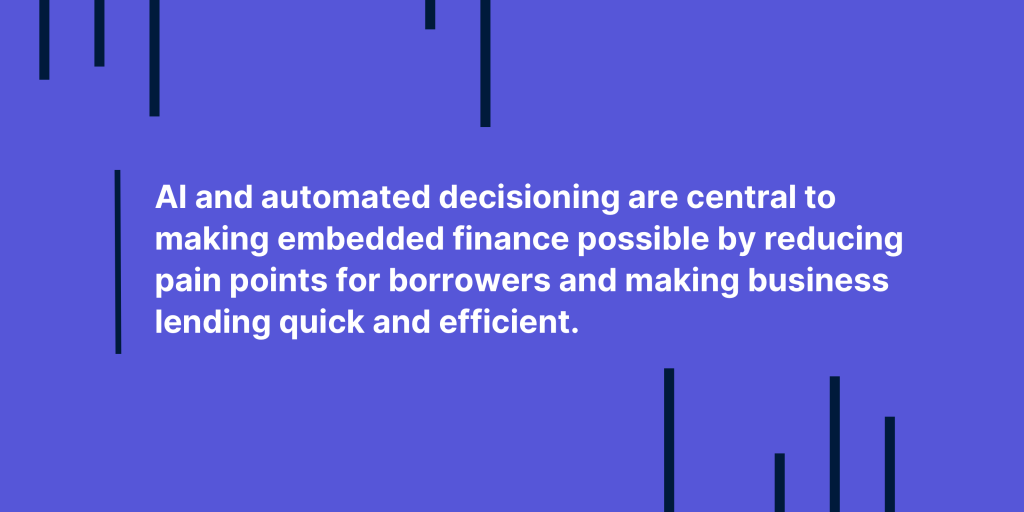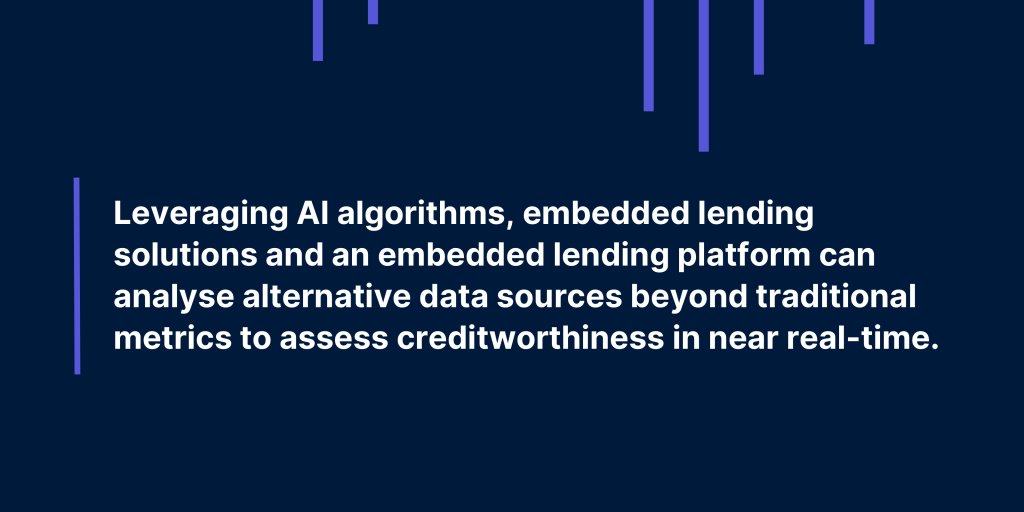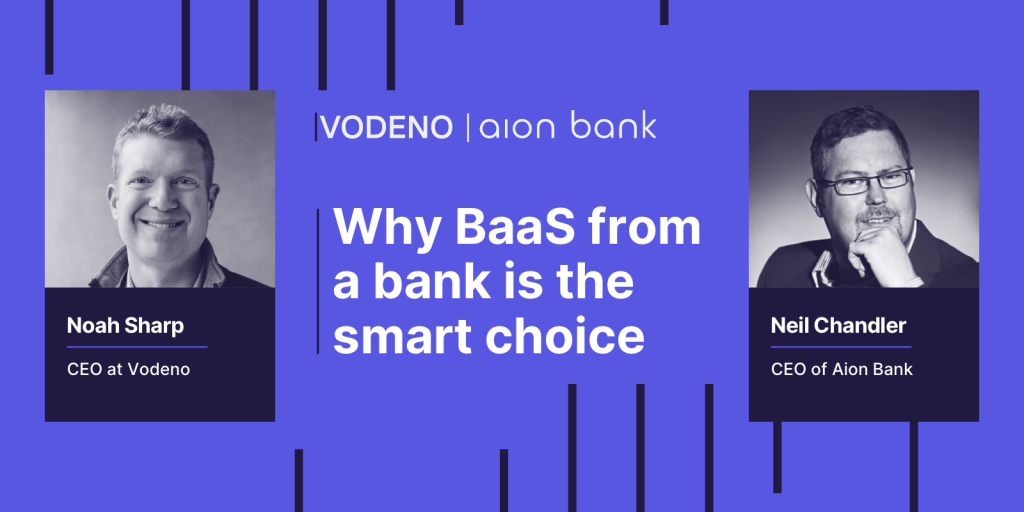The rise of embedded lending
Embedded lending, a key component of the broader concept of embedded finance, is on the rise. With myriad fintechs and brands already offering Buy Now Pay Later (BNPL) at the checkout, Bain & Company forecasts that by 2030, 20% of all lending will be embedded, while industry figures predict that retail embedded lending alone will represent a $2.1 trillion market by 2030.
The role of AI and Automation

The rise of embedded lending is hardly surprising. Providing consumers and businesses with fast, seamless access to liquidity from the brands they trust is a compelling proposition. Artificial intelligence (AI) also has an important role to play. AI and automated decisioning are central to making embedded finance (embedded lending) possible – reducing pain points for borrowers and making business lending quick and efficient, thereby enhancing the lending process.
To delve deeper into this trend, Joanna Miskiewicz, Head of Lending and BaaS Solutions at Vodeno, discusses the changing lending as a service landscape, and how AI is modernising core functions like credit decisioning, fraud, process automation, customer engagement and customer experience to meet evolving borrower needs.
Which pain points are embedded lending solving for customers?
Traditionally, lending services primarily rely on assessing a borrower’s creditworthiness. This decisioning is based on a number of conventional data sources, like credit scores, payment history and debt-to-income ratio. However, embedded lending and embedded payments, powered by AI and automation, is addressing many of the pain points experienced by both borrowers and lenders.
Streamlining the Loan Process with AI and Automation

Firstly, embedded lending significantly reduces the time and costs associated with obtaining a loan, while also streamlining underwriting the entire lending process for lenders. Leveraging AI algorithms, embedded lending solutions and an embedded lending platform can analyse alternative data sources beyond traditional metrics – everything from transaction data to social media activity and mobile data – to assess creditworthiness in near real-time. Business customers benefit from faster loan approvals, eliminating the need for extensive paperwork and manual verification, and the alternative data sets analysed provide a more accurate assessment of the individual’s creditworthiness.
Lenders benefit from a more complete picture of their customer and, in turn, a more robust decision-making process for credit products.
Enhancing Customer Experience and Boosting Conversion Rates

Another benefit of embedded lending is that it provides customers with easy access to liquidity precisely when they need it through options like buy now pay later. Integrated seamlessly at the point of purchase, customers can obtain credit when they need it in the checkout process, improving the customer experience (CX). This frictionless access to credit not only enhances customer satisfaction, but it also boosts conversion rates. According to RBC Capital Markets, BNPL increases average ticket size by between 30% to 50%, and retail conversion rates by 20% to 30%.
Embedded lending adopters also stand to gain from increased sales, size of average loan and purchase tickets. By presenting loan options during the checkout journey in a more contextualised way (at the point of need), customers are more likely to complete transactions.
Moreover, the availability of instant credit can inspire customers to explore additional products or services, leading to higher sales volumes. These benefits enhance the revenue potential for lenders and BaaS partners, while simultaneously facilitating larger purchases and financial flexibility for customers.
How is AI-powered embedded lending improving financial inclusion?

More than just a revenue opportunity, AI-powered embedded lending services are also driving financial inclusion by offering more personalised loan terms to people who have limited or no credit history.
Unlike traditional lending services that heavily rely on credit history, embedded lending analyses alternative data sources, such as transactional data to assess a person’s financial behaviour and give an accurate credit valuation. In many ways, this data is more valuable than credit history alone because it gives a more holistic view of a person’s creditworthiness. With AI and machine learning (ML) technologies in place, embedded lending platforms (e-commerce, marketplaces or mobile apps) can achieve high approval rates while maintaining credit quality, ensuring more people can access loans tailored to their specific needs.
AI Algorithms for Inclusive and Responsible Lending
The AI algorithms employed by embedded lending platforms continually learn and adapt from extensive data, allowing lenders to extend credit to a broader range of individuals while effectively managing risk. As a result, AI-powered embedded lending promotes inclusivity without compromising responsible lending practices, helping individuals build positive credit histories and access the financial resources they need.
How does embedded lending work at Vodeno/Aion?
At Vodeno, AI and ML form key components of our embedded lending offering. Underpinned by an API-based, cloud-native platform, we give our partners the ability to embed all retail and SME lending products into their offering, securely and seamlessly.

Credit and loans are made available through an end-to-end, fully automated granting process. Operating in real-time with instant money dispatch, our embedded lending solution works across all digital channels for ultimate convenience, without any additional effort required for the customer. All customers need to do is provide their consent digitally and supply basic identification data.
We take care of everything throughout the onboarding process and beyond, with full customer identification (with automated know your customer (KYC), anti-money laundering (AML) and anti-fraud checks), customer eligibility risk checks, terms and conditions signing, and money disbursement all contained in an end-to-end offering.
Final Thoughts
Embedded lending services, powered by AI and instant decisioning, are revolutionising the lending landscape by providing fast, seamless access to liquidity and streamlining processes, embedded finance transforms the way borrowers interact with financial services. AI algorithms analyse alternative data sources for real-time creditworthiness evaluations, benefiting borrowers with faster approvals and eliminating paperwork. The integration of credit options at the point of purchase enhances the customer experience, increasing conversion rates. AI-powered embedded finance and lending promotes financial inclusion by offering personalised loan terms to individuals with limited credit history. Vodeno’s embedded lending offering utilises AI and ML to provide partners with a secure and seamless platform for retail and SME lending. If you’d like to learn more about how we can support your embedded lending and embedded finance needs, get in touch today.



